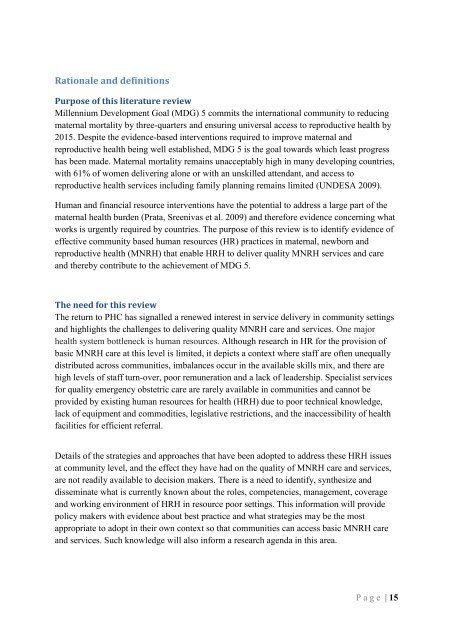Human Resources for Health in Maternal, Neonatal and - HRH ...
Human Resources for Health in Maternal, Neonatal and - HRH ...
Human Resources for Health in Maternal, Neonatal and - HRH ...
You also want an ePaper? Increase the reach of your titles
YUMPU automatically turns print PDFs into web optimized ePapers that Google loves.
Rationale <strong>and</strong> def<strong>in</strong>itions<br />
Purpose of this literature review<br />
Millennium Development Goal (MDG) 5 commits the <strong>in</strong>ternational community to reduc<strong>in</strong>g<br />
maternal mortality by three-quarters <strong>and</strong> ensur<strong>in</strong>g universal access to reproductive health by<br />
2015. Despite the evidence-based <strong>in</strong>terventions required to improve maternal <strong>and</strong><br />
reproductive health be<strong>in</strong>g well established, MDG 5 is the goal towards which least progress<br />
has been made. <strong>Maternal</strong> mortality rema<strong>in</strong>s unacceptably high <strong>in</strong> many develop<strong>in</strong>g countries,<br />
with 61% of women deliver<strong>in</strong>g alone or with an unskilled attendant, <strong>and</strong> access to<br />
reproductive health services <strong>in</strong>clud<strong>in</strong>g family plann<strong>in</strong>g rema<strong>in</strong>s limited (UNDESA 2009).<br />
<strong>Human</strong> <strong>and</strong> f<strong>in</strong>ancial resource <strong>in</strong>terventions have the potential to address a large part of the<br />
maternal health burden (Prata, Sreenivas et al. 2009) <strong>and</strong> there<strong>for</strong>e evidence concern<strong>in</strong>g what<br />
works is urgently required by countries. The purpose of this review is to identify evidence of<br />
effective community based human resources (HR) practices <strong>in</strong> maternal, newborn <strong>and</strong><br />
reproductive health (MNRH) that enable <strong>HRH</strong> to deliver quality MNRH services <strong>and</strong> care<br />
<strong>and</strong> thereby contribute to the achievement of MDG 5.<br />
The need <strong>for</strong> this review<br />
The return to PHC has signalled a renewed <strong>in</strong>terest <strong>in</strong> service delivery <strong>in</strong> community sett<strong>in</strong>gs<br />
<strong>and</strong> highlights the challenges to deliver<strong>in</strong>g quality MNRH care <strong>and</strong> services. One major<br />
health system bottleneck is human resources. Although research <strong>in</strong> HR <strong>for</strong> the provision of<br />
basic MNRH care at this level is limited, it depicts a context where staff are often unequally<br />
distributed across communities, imbalances occur <strong>in</strong> the available skills mix, <strong>and</strong> there are<br />
high levels of staff turn-over, poor remuneration <strong>and</strong> a lack of leadership. Specialist services<br />
<strong>for</strong> quality emergency obstetric care are rarely available <strong>in</strong> communities <strong>and</strong> cannot be<br />
provided by exist<strong>in</strong>g human resources <strong>for</strong> health (<strong>HRH</strong>) due to poor technical knowledge,<br />
lack of equipment <strong>and</strong> commodities, legislative restrictions, <strong>and</strong> the <strong>in</strong>accessibility of health<br />
facilities <strong>for</strong> efficient referral.<br />
Details of the strategies <strong>and</strong> approaches that have been adopted to address these <strong>HRH</strong> issues<br />
at community level, <strong>and</strong> the effect they have had on the quality of MNRH care <strong>and</strong> services,<br />
are not readily available to decision makers. There is a need to identify, synthesize <strong>and</strong><br />
dissem<strong>in</strong>ate what is currently known about the roles, competencies, management, coverage<br />
<strong>and</strong> work<strong>in</strong>g environment of <strong>HRH</strong> <strong>in</strong> resource poor sett<strong>in</strong>gs. This <strong>in</strong><strong>for</strong>mation will provide<br />
policy makers with evidence about best practice <strong>and</strong> what strategies may be the most<br />
appropriate to adopt <strong>in</strong> their own context so that communities can access basic MNRH care<br />
<strong>and</strong> services. Such knowledge will also <strong>in</strong><strong>for</strong>m a research agenda <strong>in</strong> this area.<br />
P a g e | 15

















